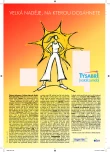The Bristol Activities of Daily Living Scale BADLS-CZ for the Evaluation of Patients with Dementia
Authors:
A. Bartoš 1,2; P. Martínek 2; D. Řípová 1
Authors‘ workplace:
AD Centrum, Psychiatrické centrum Praha
1; Univerzita Karlova v Praze, 3. LF a FN Královské Vinohrady, Neurologická klinika, Praha
2
Published in:
Cesk Slov Neurol N 2010; 73/106(6): 673-677
Category:
Original Paper
Overview
Introduction:
Deterioration in the activities of daily living (ADL) in patients with dementia may be evaluated by a questionnaire designed to be filled in by a person close to the patient. Our aim is to present a Czech version of the internationally used and recommended Bristol Activities of Daily Living Scale, BADLS-CZ. Methods: We created a BADLS-CZ questionnaire as an English translation of the original Bristol Activities of Daily Living Scale. The questionnaire is to be completed by a carer, who rates 20 activities in the patient’s life. The carer selects one of four alternative statements that correspond to various levels of performance (0–3 points). Overall functional capacity can thus be summed up as a total score (min 0 – max 60 points). Compared to the original version, our Czech adaptation includes the conversion of points to a percentage rate of self-sufficiency. The BADLS-CZ questionnaire was completed by 73 persons, of whom 23 normal elderly evaluated their own capabilities and caregivers used it to assess the ADL of 50 patients with probable Alzheimer’s disease. At the same time, cognitive performance was assessed by means of the Mini-Mental State Examination. Results: The carers of the 50 patients with AD (MMSE 17 ± 5 points) evaluated ADL with the following results (mean ± standard deviation): BADLS-CZ score 17 ± 9 points, median 16 points, min–max 2–39 points; 71% ±14% self-sufficiency, median 73%, min–max 35%–96%. ADL results according to BADLS-CZ were significantly associated with MMSE (Spearman r = 0.5; p = 0.0002), but not influenced by age, education or gender of the patients. Completing the questionnaire was easy and usually took 6–12 minutes. Conclusion: The BADLS-CZ questionnaire, designed to be completed by a close carer, extends the options for structured evaluation of basic and instrumental ADL in patients with dementia, including AD, in the Czech Republic, and is freely available at www.pcp.lf3.cuni.cz/adcentrum.
Key words:
activities of daily living – Alzheimer disease – dementia – The Bristol Activities of Daily Living Scale – questionnaires – functional impairment
Sources
1. Petersen RC, Stevens JC, Ganguli M, Tangalos EG, Cummings JL, DeKosky ST. Practice parameter: early detection of dementia: mild cognitive impairment (an evidence-based review). Report of the Quality Standards Subcommittee of the American Academy of Neurology. Neurology 2001; 56(9): 1133–1142.
2. Ressner P, Hort J, Rektorová I, Bartoš A, Rusina R, Línek V et al. Doporučené postupy pro diagnostiku Alzheimerovy nemoci a dalších onemocnění spojených s demencí. Cesk Slov Neurol N 2008; 71/104(4): 494–501.
3. Rektorová I. Neurodegenerativní demence. Cesk Slov Neurol N 2009; 72/105(2): 97–109.
4. Gélinas I, Gauthier L, McIntyre M, Gauthier S. Development of a functional measure for persons with Alzheimer’s disease: the disability assessment for dementia. Am J Occup Ther 1999; 53(5): 471–481.
5. Bartoš A, Martínek P, Buček A, Řípová D. Dotazník soběstačnosti DAD-CZ – česká verze pro hodnocení každodenních aktivit pacientů s Alzheimerovou nemocí. Neurol pro praxi 2009; 10(5): 320–323.
6. Bucks RS, Ashworth DL, Wilcock GK, Siegfried K. Assessment of activities of daily living in dementia: development of the Bristol Activities of Daily Living Scale. Age Ageing 1996; 25(2): 113–120.
7. Sikkes SA, de Lange-de Klerk ES, Pijnenburg YA, Scheltens P, Uitdehaag BM. A systematic review of Instrumental Activities of Daily Living scales in dementia: room for improvement. J Neurol Neurosurg Psychiatry 2009; 80(1): 7–12.
8. Kalvach Z. Hodnocení soběstačnosti a výkonnosti. In: Kalvach Z et al (eds). Geriatrie a gerontologie. Praha: Grada 2004: 196–203.
9. Topinková E. Geriatrie pro praxi. Praha: Galén 2005.
10. Bartoš A, Martínek P, Bezdíček O, Buček A, Řípová D. Dotazník funkčního stavu FAQ-CZ – česká verze pro zhodnocení každodenních aktivit pacientů s Alzheimerovou nemocí. Psychiat pro Praxi 2008; 9(1): 31–34.
11. Martínek P, Bartoš A. Aktivity denního života pacientů s Alzheimerovou nemocí očima jejich pečovatelů. Čes Ger Rev 2008; 6(3): 186–192.
12. Folstein MF, Folstein SE, McHugh PR. “Mini-Mental State”. A practical method for grading the cognitive state of patients for the clinician. J Psychiat Res 1975; 12(3): 189–198.
13. Byrne LM, Wilson PM, Bucks RS, Hughes AO, Wilcock GK. The sensitivity to change over time of the Bristol Activities of Daily Living Scale in Alzheimer’s disease. Int J Geriatr Psychiatry 2000; 15(7): 656–661.
14. McKhann G, Drachman D, Folstein M, Katzman R, Price D, Stadlan EM. Clinical diagnosis of Alzheimer’s disease: report of the NINCDS-ADRDA Work Group under the auspices of Department of Health and Human Services Task Force on Alzheimer’s Disease. Neurology 1984, 34(7): 939–944.
15. Dušek L, Pavlík T, Koptíková J. Analýza dat v neurologii. XVII. Neparametrické testy jako alternativa t-testu. Cesk Slov Neurol N 2009; 72/105(5): 482–485.
16. Bucks RS, Haworth J. Bristol Activities of Daily Living Scale: a critical evaluation. Expert Rev Neurother 2002; 2(5): 669–676.
Labels
Paediatric neurology Neurosurgery NeurologyArticle was published in
Czech and Slovak Neurology and Neurosurgery

2010 Issue 6
Most read in this issue
- Spontaneous Regression of Sequestrated Lumbar Disc Herniation – Three Case Reports
- Assessment of State of Health and Capacity for Work in Post-Stroke Patients – Case Reports
- The Bristol Activities of Daily Living Scale BADLS-CZ for the Evaluation of Patients with Dementia
- Autisms
